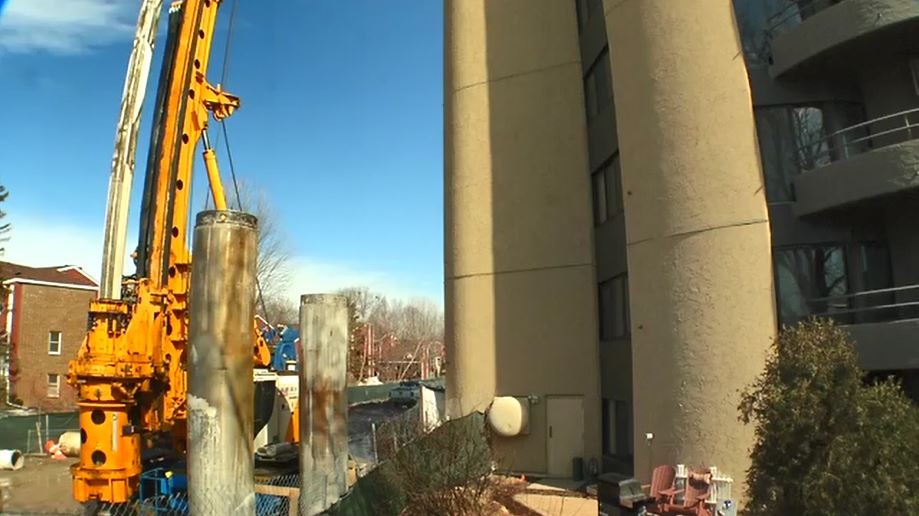As work resumes at ‘pinch point’ on Southwest light rail, condo owners say costly delays predictable and preventable
[anvplayer video=”5107002″ station=”998122″]
Workers are poised to restart construction on a small part of the controversial Southwest light rail project that has been on hold for the past three months.
The problem-plagued section, just 2,800 feet along the Kenilworth corridor in Minneapolis, is largely blamed for months of delays and cost overruns, pushing the total estimated bill for taxpayers to $2.75 billion.
It is still unclear where the state will get an additional $550 million in funding needed to finish the 14 ½ mile line, but engineers say work can now safely resume on a key tunnel.
In January, work suddenly stopped in that section after condo owners who live mere inches from the construction reported damage.
A 5 INVESTIGATES review of emails, public statements, and other reports found new evidence of early warnings that accurately predicted some of the issues now jeopardizing the largest civil construction project in Minnesota history.
A 5 INVESTIGATES review of emails, public statements, and other reports found new evidence of early warnings that accurately predicted some of the issues now jeopardizing the largest civil construction project in Minnesota history.
Homeowners in the area say their concerns were ignored.
Damage predicted
Cherie Hamilton says cracks started appearing in the walls and ceiling of her tenth-floor unit at the Cedar Isles condominiums in December last year.
Construction on the new light rail line is directly below her balcony.
“They said take pictures off the wall,” Hamilton said. “That said to me that something is going to be shaking in here, you know?”
She says the shaking continued until project managers halted construction after more cracks appeared throughout the condo buildings and an adjacent townhome in January.
In February, a broken water main on the construction site flooded the condo’s parking garage.
The wave of problems, delays, and cost increases has prompted a state audit and criticism from both Republican and DFL lawmakers, including some who now call the light rail project a ‘boondoggle.’

None of it comes as a surprise to members of the Cedar Isles Condo Association (CICA), including Vanne Owens Hayes.
“We could write a book on ‘I told you so’ because we’ve had experts project different outcomes, and the outcomes are what we’re experiencing,” Owens Hayes said.
Another resident, Russell Palma, first voiced his concerns about the proposed route for the Southwest light rail line in 2014.
“The proposed alignment makes little sense,” Palma wrote at the time in a statement to the Federal Transit Administration (FTA).
“It just didn’t make any sense at some point to continue along the alignment that they had set up, but they did anyway,” Palma said in a recent interview.
The condo owners also hired an engineering firm in 2018, which warned of potential damage to the buildings, noting that the “structures are substantially more susceptible to vibration impacts” from construction.
“We could write a book on ‘I told you so’ because we’ve had experts project different outcomes and the outcomes are what we’re experiencing.”
-Vanne Owens Hayes
Despite those warnings, the FTA awarded the project a Full Funding Grant Agreement worth almost $1 billion in 2020.
Mary Pattock, the former chair of the Cedar Isles-Dean Neighborhood Association, is among those who say they were dismissed as ‘NIMBY’s’ (not-in-my-back-yard) for raising concerns about running the new light rail line through a ’pinch point’ near the condo buildings.
In an email from 2018, Pattock predicted the Metropolitan Council and the FTA would “move ahead with the project, allow the worst to happen, and then say … to taxpayers, ‘So sorry, we need another $60 million.’”
“They need $550 million. I was wrong on that minor point,” Pattock said in an interview last month with 5 INVESTIGATES. “We told them about the cost, we told them all of these things. And I would like to know … what did they do with that information?”
The ultimate price
As 5 INVESTIGATES first reported in April, an engineering firm hired by the Met Council to investigate the cracks at the Cedar Isles condos recently concluded that the buildings were safe and the work in the area could resume.
“I’m not an engineer, but I can read what they told us – this building is safe and the project can proceed,” Zelle said.
The firm also minimized the role that construction played in the damage. It largely blamed changing weather conditions and the design of the structures, which were converted from grain silos in the 1980’s.
“Any public officials who believe that, I have a bridge I want to sell them,” Pattock said in response to the findings. “It’s totally ridiculous.”
Homeowners such as Kim Myers fear the worst is yet to come.
“I’m not an engineer, but I can read what they told us – this building is safe and the project can proceed.”
-charlie zelle, met council chair
“I don’t know what I’m going to do or how I can live,” Myers said.
She says she may have to delay her retirement because she has been unable to sell her first floor unit. Large construction equipment sits just feet from her patio.
“What I’ve heard back … is, ‘oh, that building? We’re not interested,’” Myers said. “I now have a property that is worth essentially zero.”
The ultimate cost to taxpayers is still undetermined.
“We were saying, ‘we know what’s going on here, you can’t do that,” Pattock said. “They refused to listen to us.”